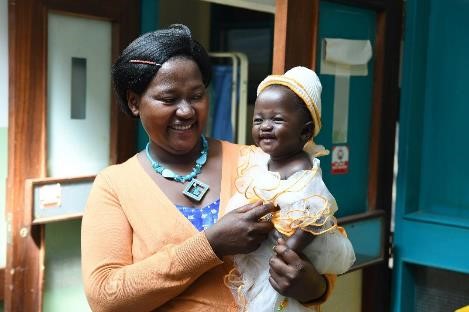Immaculate Nakito gave birth prematurely to her daughter at a primary health center near her home in Uganda. After just five and a half months gestation, baby Judith weighed less than two pounds.
Recognizing that Judith needed specialized care to survive, her father took her by boda boda in the middle of the night to the Special Care Newborn Unit (SCNU) at Kagadi Hospital, where she received life-saving medical attention.
Immaculate told us, “I thought my baby was going to die.” But after one month in the SCNU, Judith was sent home without any lasting complications. At the time this photo was taken, she was about to turn one.
In the SCNU, Judith benefited from high quality care performed by skilled midwives, who had access to functioning equipment, because of support from a unique public-private partnership, Saving Mothers, Giving Life (SMGL). This ambitious five-year effort set out to achieve dramatic reductions in maternal and newborn mortality in Nigeria, Uganda and Zambia.
But not everyone is as lucky as Immaculate and Judith. Sub-Saharan Africa accounts for 38% of global newborn deaths1, and progress to reduce neonatal mortality in the region is among the slowest in the world2.
SMGL’s Approach
We believe that a comprehensive, health system-wide approach is key to ensuring that mom and baby both thrive during pregnancy and childbirth. That is why SMGL, led by the U.S. Government, brought together a diverse group of partners to address the delays in seeking, accessing and receiving life-saving care for mothers and newborns.
To reduce newborn mortality, we trained health workers to teach women and communities the importance of antenatal and postnatal care, recognize signs of potential obstetric and newborn complications, plan for delivery in a high-quality facility and overcome transportation challenges. SMGL prepared physicians, midwives and nurses to provide essential newborn care and special care for small and sick babies. We built newborn corners for resuscitation and SCNUs – like the one where Judith received care – and empowered providers to refer babies to these facilities.
What We Learned
Despite this intense effort, we faced challenges in reducing newborn deaths throughout the partnership. Mid-way through the initiative, we intensified our efforts in newborn health and, looking back on the last five years of SMGL, we’re proud of what our partnership has achieved.
SMGL’s programs in Nigeria are still ongoing, but rigorous evaluation in Uganda and Zambia shows:
• Neonatal mortality rates at SMGL facilities declined by 10% in Uganda and 41% in Zambia.
• Stillbirth rates in SMGL facilities dropped 36% in Uganda and 39% in Zambia.
• 88% of SMGL facilities in Uganda and 75% in Zambia now report successful resuscitation of newborns born with difficulty breathing, compared to just 32% and 27% (respectively) five years ago.
We recognize that reduction in the neonatal mortality rates in Uganda and Zambia are highly uneven, even in the face of comparable interventions. Further research is needed to better understand the underlying factors. We can say that over the 5 years of SMGL implementation in Zambia, we witnessed an interesting progression: a marked decrease in stillbirths preceded that for newborns. We are hopeful this pattern will also play out in Uganda in the future.
What’s Next
Reflecting on lessons learned from SMGL, I am convinced that a comprehensive approach to strengthening district-wide health systems is critical to protect mothers and their newborns. In global health, we tend to silo our programming to either focus on mom or baby. We must focus on the mother-newborn dyad to encourage the best possible birth outcomes for both. We must also increase programming to ensure that sick and small newborns receive the specialized care that they need.
Looking ahead, our host government partners have already taken ownership over many of SMGL’s strategies – the key to sustainability – and we are confident that this approach holds great promise for accelerating progress toward the Sustainable Development Goals.
For more information about SMGL, please visit our website and read our final report.
1https://www.unicef.org/reports/levels-and-trends-child-mortality-report-2017
2https://data.unicef.org/topic/child-survival/neonatal-mortality/#
Image credit goes to Amy Fowler, USAID.
